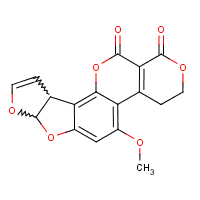Aflatoxins
Agent Name
Aflatoxins
CAS Number
1402-68-2
Formula
Unspecified
Major Category
Biological Agents

Category
Mycotoxins
Sources/Uses
Used in molecular biology research; [HSDB] "Occupational exposure can occur through the handling and processing of aflatoxin-contaminated crops. Low-level respiratory exposure to aflatoxin-contaminated dust particles was reported in workers processing imported maize and in workers extracting oil from linseeds and groundnuts. Dust levels of aflatoxin collected at different animal feed production sites ranged from none detectable to 8 ug/kg dust. In a study of 45 male workers at 2 Danish livestock feed processing companies, respiratory exposure to aflatoxins was reported; the mean level of positive samples was expressed as 64 ng/d/kg body weight. Monitoring data indicate that the general population is predominately exposed to aflatoxins via the ingestion of food and may be exposed through dermal contact with this compound and other products containing aflatoxins (SRC). Exposure can occur due to the presence of aflatoxin and aflatoxin metabolites in milk and milk products from animals that have consumed contaminated feed." [IARC]
Comments
The LDLo in humans after an oral dose is 0.229 mg/kg with effects including bleeding from the small intestine and jaundice. [ChemIDplus] A mycotoxin produced by Aspergillus species, aflatoxin may contaminate corn and peanuts stored in a warm, damp environment. The four main aflatoxins are B1,B2, G1, and G2. Animal experiments have shown aflatoxin B1 (AFB1) to be a strong hepatic carcinogen. [Schottenfeld, p. 769] Aflatoxin is one of the "Substances and Mixtures That Have Been Evaluated by IARC as Definite (Group 1) Human Carcinogens and Are Occupational Exposures." The high-risk occupational exposures are "Feed production industry, workers loading and unloading cargo; rice and maize processing." [Siemiatycki, p. 327] Mycotoxins produced by many Aspergillus mold species that grow on and contaminate commodities (i.e. cereals, oilseeds, nuts, and tobacco) in the field or in storage; Can also be found in milk products of animals ingesting contaminated feed; Over a dozen aflatoxins have been identified, with many being mammalian biotransformation products of the major metabolites; Associated with increased mortality in livestock and toxicity and carcinogenicity in humans and animals; Chronic toxicosis can cause cancer, immune suppression, and other conditions; The liver has been shown to be the primary target organ in experimental animals; Epidemiological evidence suggests that aflatoxin ingestion may increase the risk of hepatic cancer, and occupational inhalation may increase the risk of respiratory cancer; Approximate lethal dose in humans is 10-20 mg; Aflatoxin B1 is the most powerful naturally occurring animal carcinogen known; [Reference #1]
Reference Link #1
Biomedical References
Exposure Assessment
Vapor Pressure
1.25E-10 mm Hg
Adverse Effects
Hepatotoxin
Hepatoxic (a) from occupational exposure (secondary effect) or (b) in animal studies or in humans after ingestion
IARC Carcinogen
Established
NTP Carcinogen
Human carcinogen
Diseases, Processes, and Activities Linked to This Agent
Diseases
Occupational diseases associated with exposure to this agent:
Processes
Industrial Processes with risk of exposure: